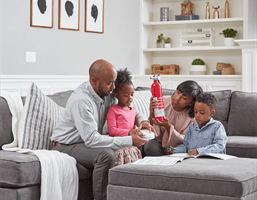
The do’s and don’ts of home safety
The best defense against a home emergency is prevention. To ensure your family is taking preventative measures and practicing whole home safety, everyone should know these six do’s and don’ts of fire safety.
Don’t forget about carbon monoxide.
Throughout the colder months, the risk of CO poisoning increases dramatically. The invisible, odourless gas is produced by fuel-burning devices such as stoves, generators and fireplaces, and can only be detected with a dedicated alarm. Have your appliances professionally inspected every year and install CO alarms in your home.
Do install smoke and CO alarms in your home.
For the best protection, install smoke alarms on each level of your home, including the basement, and in every bedroom. Install CO alarms on every level and near all sleeping areas. Remember that alarms don’t last forever, so replace outdated units. If you can’t remember the last time you installed an alarm, chances are, it’s time to replace it. Alarms are on duty 24/7 and need to be replaced at least every 10 years.
Don’t forget to check your alarms regularly.
Once your smoke and CO alarms are installed, test them regularly and change the batteries at least every six months. For convenient protection, upgrade to First Alert 10-year smoke and carbon monoxide alarms, which eliminate battery replacements and late-night battery chirps for a decade.
Do keep a fire extinguisher on hand.
Beyond alarms, having fire extinguishers — and knowing how to use them — is an important part of maintaining a safe home for you and your family. Place fire extinguishers on every level and in high-risk rooms such as the kitchen and garage.
Don’t leave food unattended when cooking.
The National Fire Protection Association reports that unattended cooking is the number one cause of home fires. Whether you are using the stovetop or oven, be sure to always remain in the kitchen. Clear the area around your stovetop of fire hazards, including items that can catch fire such as paper towels or dish towels.
Do have an emergency escape plan.
Develop a plan and practice it with the entire family twice a year. Walk through your home as a family and identify two exits out of each room, including windows and doors. Your family should also pick a designated meeting spot a safe distance away from the house. Once outside, stay outside, dial 911 and wait for emergency responders to arrive.
Learn more about home safety at firstalert.ca.
credit – newscanada.com

Leave A Comment
You must be logged in to post a comment.